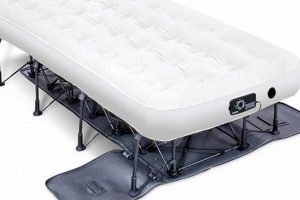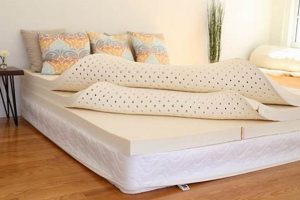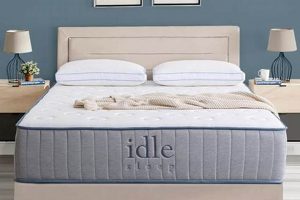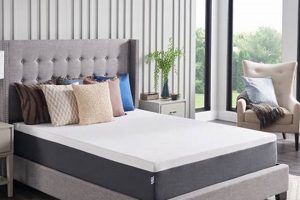A sleep surface designed to alleviate pressure points and provide optimal support for individuals with joint pain and bone density issues can significantly impact comfort and sleep quality. Such a surface aims to minimize discomfort arising from these conditions, facilitating restful sleep and potentially reducing pain exacerbation.
Selecting an appropriate sleep surface offers numerous advantages, including decreased pain levels during sleep, improved spinal alignment, and enhanced overall restfulness. Historically, individuals with these conditions were often limited in their options, but advancements in materials science and mattress technology have expanded the availability of surfaces tailored to their specific needs. These tailored mattresses can contribute to improved daily function and a higher quality of life.
The following sections will explore key considerations when choosing a sleep surface for individuals experiencing joint and bone health challenges, focusing on material properties, support systems, and other relevant factors influencing sleep comfort and well-being.
Tips for Selecting a Suitable Mattress
Choosing a mattress requires careful consideration of individual needs, particularly when managing arthritis and osteoporosis. The following tips offer guidance in making an informed decision.
Tip 1: Prioritize Pressure Relief. Mattresses should conform to the body’s contours, minimizing pressure on joints. Memory foam or latex materials often provide effective pressure relief.
Tip 2: Ensure Adequate Support. Proper spinal alignment is crucial. A mattress should offer sufficient support to prevent sinking or sagging, which can exacerbate pain.
Tip 3: Consider Mattress Firmness. The ideal firmness level is subjective but generally, medium-firm mattresses are often recommended for individuals with arthritis. However, personal preference and specific condition severity should guide the decision.
Tip 4: Evaluate Material Composition. Hypoallergenic materials are advantageous to minimize allergic reactions that could disrupt sleep. Certifications such as CertiPUR-US ensure materials are free from harmful chemicals.
Tip 5: Explore Adjustable Beds. Adjustable beds allow for customizable positioning, which can reduce pressure on specific areas and improve circulation. Elevating the head or legs can alleviate discomfort.
Tip 6: Review Trial Periods and Warranties. Many mattress companies offer trial periods, allowing individuals to test the mattress at home. A comprehensive warranty provides assurance against defects.
Tip 7: Consult Healthcare Professionals. Seeking advice from a physician or physical therapist can provide personalized recommendations based on individual health needs and conditions.
Selecting an appropriate mattress necessitates a thorough understanding of individual requirements and available options. Prioritizing pressure relief, support, and material composition can contribute to improved sleep quality and reduced discomfort.
The subsequent sections will delve into specific mattress types and technologies that are commonly recommended for those seeking relief from the symptoms of arthritis and osteoporosis.
1. Pressure Point Relief
Pressure point relief is a critical consideration when selecting a mattress, particularly for individuals with arthritis and osteoporosis. Minimizing pressure on joints and bony prominences is essential for pain management and promoting restorative sleep.
- Conformity to Body Contours
Mattresses that conform to the body’s unique contours distribute weight evenly, reducing localized pressure. Memory foam and latex are materials known for their conforming properties. Without adequate contouring, pressure accumulates at specific points like hips, shoulders, and knees, exacerbating pain associated with arthritis and osteoporosis.
- Reduction of Joint Compression
Joint compression can lead to increased inflammation and discomfort. A mattress designed for pressure relief minimizes this compression, allowing for improved blood flow and reduced pain signals. Materials with a high degree of elasticity, such as certain types of foam, are effective in redistributing pressure away from sensitive joints.
- Support for Spinal Alignment
While pressure relief is essential, adequate spinal support is equally important. Maintaining proper spinal alignment prevents strain on back muscles and reduces pressure on spinal joints. Mattresses should provide sufficient support to prevent sinking or sagging, which can compromise spinal alignment and negate the benefits of pressure relief.
- Influence on Sleep Quality
Effective pressure point relief translates directly to improved sleep quality. Reduced pain and discomfort allow for deeper, more restful sleep cycles. This is particularly beneficial for individuals with chronic pain conditions like arthritis and osteoporosis, as sleep deprivation can worsen pain perception and overall health.
The interplay between conformity, joint compression reduction, spinal alignment, and sleep quality underscores the importance of pressure point relief in the context of mattresses designed for individuals with arthritis and osteoporosis. Choosing a mattress that prioritizes these factors can significantly impact pain management and overall well-being.
2. Spinal Alignment Support
Spinal alignment support is a foundational element in determining the suitability of a sleep surface, particularly for individuals with arthritis and osteoporosis. The spine’s natural curvature must be maintained during sleep to minimize stress on vertebral joints and surrounding tissues. A mattress that fails to provide adequate support can lead to spinal misalignment, exacerbating existing pain and contributing to further musculoskeletal issues. For instance, a mattress that is too soft allows the hips and shoulders to sink, creating a U-shaped spinal curvature that strains the lower back. Conversely, a mattress that is too firm may not conform to the body’s contours, resulting in pressure points and an unnatural arch in the spine.
The relationship between spinal alignment and pain reduction is well-documented. Proper alignment promotes even weight distribution, decreasing pressure on individual joints and reducing inflammation. A medium-firm mattress, often recommended for arthritis and osteoporosis, strikes a balance between support and cushioning. This firmness level prevents excessive sinking while still allowing the mattress to conform to the body’s shape. Adjustable beds, which allow users to customize the angle of the head and legs, offer another aven
ue for achieving optimal spinal alignment and alleviating pressure. Real-world examples include individuals with lumbar spinal stenosis finding relief by slightly elevating their knees, reducing pressure on the lower back.
In conclusion, spinal alignment support is not merely a desirable feature, but a critical requirement for a mattress intended to benefit those with arthritis and osteoporosis. The selection process should prioritize mattresses that effectively maintain the spine’s natural curvature, promoting pain reduction, improved sleep quality, and enhanced overall well-being. Overlooking this crucial aspect can negate other potential benefits and potentially worsen existing conditions. Therefore, a careful assessment of a mattress’s ability to provide adequate spinal alignment support is paramount in making an informed decision.
3. Material Composition
Material composition is a critical determinant in the suitability of a mattress for individuals with arthritis and osteoporosis. The materials used directly influence pressure relief, support, temperature regulation, and allergenicity, all factors impacting sleep quality and symptom management.
- Memory Foam Density and Type
Memory foam’s density dictates its ability to contour to the body and distribute weight evenly. Higher density foams offer enhanced pressure relief but may retain heat. Open-cell memory foam, conversely, promotes airflow and reduces heat buildup. For individuals with arthritis, optimal memory foam mattresses alleviate pressure on joints, while those with osteoporosis benefit from the added support preventing spinal compression.
- Latex (Natural vs. Synthetic)
Latex provides a resilient and supportive surface. Natural latex, derived from rubber trees, is inherently hypoallergenic and breathable. Synthetic latex, often made from petroleum-based materials, may lack these advantages. People dealing with arthritis and osteoporosis often find natural latex helpful because it eases pressure points, is eco friendly, and is less likely to cause allergic reactions.
- Innerspring Coil Count and Gauge
In innerspring mattresses, coil count and gauge influence support and durability. Higher coil counts generally offer better support and contouring. Coil gauge, a measure of wire thickness, affects firmness. Individuals with arthritis or osteoporosis need to choose a coil system that offers sufficient support to maintain spinal alignment without creating pressure points. Mattresses must be firm and comfortable.
- Cover Fabric and Breathability
The fabric covering a mattress affects temperature regulation and moisture management. Breathable materials, such as cotton or bamboo, promote airflow and prevent overheating. Hypoallergenic covers minimize exposure to dust mites and other allergens. Individuals with arthritis and osteoporosis benefit from breathable fabrics that prevent overheating, ensuring a comfortable sleep environment.
The selection of mattress materials is a nuanced process that requires careful consideration of individual needs and sensitivities. Prioritizing materials known for pressure relief, support, breathability, and hypoallergenic properties is essential in choosing a mattress that promotes restful sleep and symptom management for individuals with arthritis and osteoporosis. Different mattress types address the different needs of people dealing with such medical issues.
4. Optimal Firmness Level
Optimal firmness level plays a critical role in determining the effectiveness of a mattress for individuals managing arthritis and osteoporosis. An unsuitable firmness can exacerbate pain and discomfort, negating other beneficial features. The connection stems from the mattress’s ability to properly support spinal alignment and distribute pressure across the body. Mattresses that are too soft fail to provide adequate support, leading to spinal misalignment and increased pressure on joints. Conversely, excessively firm mattresses may not conform to the body’s contours, resulting in pressure points, particularly at the hips and shoulders. The “just right” firmness is vital.
The ideal firmness level varies based on individual factors such as body weight, sleep position, and the specific locations and severity of arthritis or osteoporosis. A lighter individual may find a medium-firm mattress to be sufficiently supportive, while a heavier person may require a firmer surface to prevent excessive sinking. Side sleepers often benefit from a slightly softer mattress that allows the shoulder and hip to sink in, maintaining spinal alignment. Back sleepers generally require a firmer surface to prevent the hips from sinking too far, which can strain the lower back. Real-world examples highlight these nuances: an individual with osteoporotic compression fractures might require a firmer mattress to stabilize the spine, whereas someone with rheumatoid arthritis in multiple joints might prefer a medium-firm option that provides pressure relief without compromising support. One of the best mattresses can have this feature.
Selecting a mattress with the optimal firmness level requires careful consideration and often involves trial and error. Many mattress retailers offer trial periods, allowing individuals to test the mattress in their home environment. Consulting with a healthcare professional, such as a physical therapist, can also provide personalized recommendations based on individual needs. Ultimately, understanding the connection between optimal firmness level and spinal alignment, pressure distribution, and individual factors is crucial for selecting a mattress that effectively alleviates pain and promotes restful sleep for individuals with arthritis and osteoporosis.
5. Motion Isolation
Motion isolation is a critical characteristic of a sleep surface, particularly when considering individuals with arthritis and osteoporosis who may experience increased sensitivity to movement and disturbances during sleep. Minimizing the transfer of motion can contribute to a more restful and uninterrupted sleep experience.
- Reduced Sleep Disturbance
Effective motion isolation minimizes disturbances caused by a partner’s movements during sleep. For individuals with arthritis or osteoporosis, even slight disruptions can exacerbate pain and impede the restorative sleep process. A mattress that effectively absorbs and isolates motion prevents these disturbances, promoting deeper sleep cycles and improved comfort.
- Material Properties and Dampening Effects
Certain mattress materials exhibit superior motion isolation properties. Memory foam and latex, for example, possess inherent damping characteristics that absorb and minimize motion transfer. The density and composition of these materials contribute to their ability to isolate movement, preventing it from propagating across the mattress surface. In contrast, traditional innerspring mattresses with interconnected coils may exhibit greater motion transfer due to the interconnected nature of the coils.
- Construction Techniques and Layering
Mattres
s construction techniques also play a significant role in motion isolation. Hybrid mattresses that combine layers of memory foam or latex with a pocketed coil system can offer a balance of support and motion isolation. Pocketed coils, individually wrapped in fabric, move independently, minimizing motion transfer compared to interconnected coil systems. Layering different materials with varying densities and damping properties can further enhance motion isolation performance. - Impact on Pain Management
By minimizing sleep disturbances, effective motion isolation can contribute to improved pain management for individuals with arthritis and osteoporosis. Uninterrupted sleep allows for more complete restorative processes, potentially reducing inflammation and pain perception. A sleep partner’s movements will be negligible. Furthermore, reducing the frequency of awakenings can prevent the muscle tension and stiffness that often accompany sleep disruptions, providing greater comfort and mobility upon waking.
The interconnected relationship between reduced sleep disturbance, material properties, construction techniques, and pain management underscores the importance of motion isolation in the context of selecting a mattress for individuals with arthritis and osteoporosis. Prioritizing mattresses with demonstrable motion isolation capabilities can significantly enhance sleep quality and contribute to improved overall well-being.
Frequently Asked Questions
This section addresses common inquiries regarding the selection of mattresses suitable for individuals managing arthritis and osteoporosis, providing clear and concise answers based on current knowledge.
Question 1: What mattress type is generally recommended for individuals with arthritis?
Generally, a medium-firm mattress is recommended. This firmness level aims to provide adequate support for spinal alignment while offering sufficient cushioning to alleviate pressure on sensitive joints.
Question 2: How does memory foam benefit individuals with osteoporosis?
Memory foam conforms to the body’s contours, distributing weight evenly and minimizing pressure points. This can be particularly beneficial for individuals with osteoporosis, reducing stress on fragile bones and potentially preventing pain exacerbation.
Question 3: Are adjustable beds advantageous for individuals with these conditions?
Adjustable beds allow for customized positioning, enabling individuals to elevate their head or legs to alleviate pressure on specific areas. This can improve circulation and reduce discomfort associated with arthritis and osteoporosis.
Question 4: What mattress materials should be avoided by individuals with allergies or sensitivities?
Individuals with allergies or sensitivities should avoid mattresses containing materials known to trigger allergic reactions, such as certain synthetic latex formulations or conventional innerspring components. Hypoallergenic materials, such as natural latex or certified foams, are preferable.
Question 5: How important is motion isolation for co-sleeping individuals?
Motion isolation is crucial for co-sleeping individuals, particularly when one partner experiences pain or sensitivity. A mattress with good motion isolation minimizes disturbances caused by movement, promoting more restful sleep for both individuals.
Question 6: How can individuals assess the suitability of a mattress before purchase?
Many mattress companies offer trial periods, allowing individuals to test the mattress at home. This provides an opportunity to evaluate comfort and support over an extended period before committing to a purchase. Reviewing warranty terms is also advisable.
Selecting an appropriate mattress involves considering various factors, including firmness, material composition, and individual needs. Consulting with a healthcare professional can provide personalized recommendations.
The subsequent section will explore advanced technologies and features incorporated into mattresses designed to enhance comfort and support for individuals managing these conditions.
Conclusion
The exploration of the best mattress for arthritis and osteoporosis has revealed a multifaceted landscape of considerations. Factors such as pressure relief, spinal alignment support, material composition, optimal firmness level, and motion isolation have been established as critical determinants in selecting a sleep surface that effectively addresses the unique needs of individuals managing these conditions. Prioritizing these aspects can significantly impact sleep quality and overall well-being.
The information presented serves as a foundation for informed decision-making. Individuals are encouraged to consult healthcare professionals and thoroughly evaluate available options before making a purchase. Continuous advancements in sleep technology promise further innovations aimed at enhancing comfort and alleviating the symptoms of arthritis and osteoporosis, fostering improved quality of life through optimized sleep environments.







![Top-Rated: Best Foam Mattress for Camping - [Year] Guide Organic & Natural Mattress Buyer’s Guide: Non-Toxic Sleep Solutions Top-Rated: Best Foam Mattress for Camping - [Year] Guide | Organic & Natural Mattress Buyer’s Guide: Non-Toxic Sleep Solutions](https://mattressworldpa.com/wp-content/uploads/2025/07/th-7661-300x200.jpg)